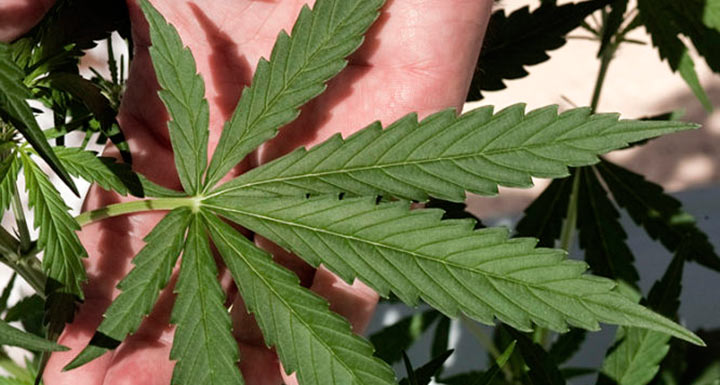
Study suggests medical marijuana reduces opiate overdoses
The study, published in theJournal of the American Medical Association,estimated a reduction of about 1,700 overdoses in 2010 in the 13 states that had medical marijuana systems up and running then.
The association seemed to strengthen as years passed. Overdose rates averaged 20 percent lower than expected a year after medical marijuana was allowed and 33 percent lower by the sixth year.
“This suggests an unexpected public health benefit from medical marijuana laws,” said lead author Marcus Bachhuber, a researcher at Philadelphia’s VA Medical Center.
The numbers did not prove cause and effect. In fact, the authors said that unrelated factors — like cultural shifts — might account for the lower overdose rates.
But they theorized that marijuana might lead people to take fewer painkillers. Or perhaps pot relaxes people, so they take fewer anti-anxiety drugs and anti-depressants that can lead to “drug cocktail” overdoses.
Severe pain is by far the dominant diagnosis among medical pot users in the medical marijuana states that keep statistics. In Colorado, 94 percent of patients list it as a symptom.
Opioid painkillers, like OxyContin and Percocet, sometimes work poorly for chronic pain patients because tolerance builds, Maine physicians Marie Hayes and Mark Brown noted in JAMA‘s commentary section.
“The striking implication (of the study) is that medical marijuana laws . . . may represent a promising approach for stemming runaway rates” of opiate overdose.
Floridians will vote Nov. 4 on proposed constitutional Amendment 2, which would allow medical marijuana with a doctor’s certificate. Advocates and opponents offered differing views Tuesday of theJAMA study.
“Having marijuana available as an alternative to dangerous narcotics could decrease their use and abuse in our state,” said Ben Pollara, campaign manager for United for Care. “Opponents of Amendment 2 trying to scare voters by likening medical marijuana to pill mills clearly need to find a new argument.”
Calvina Fay, executive director of St. Petersburg’s Drug Free America Foundation, disagreed.
“Much more research must be done before making a far-reaching conclusion that medical marijuana laws reduce opiate overdose,” she said.
Among other things, the 13 states studied had high opiate overdose rates before they passed medical marijuana laws. Opiate overdose rates rose more slowly after passage, plateaued, then dropped — but still remained above the national average.
Perhaps authorities in those states were worried about their opioid problems, Fay theorized. Or, maybe more aggressive educational, rehabilitative and law enforcement efforts led to lower overdose rates — not medical marijuana.
The study did factor in prescription drug monitoring programs through 2010 and found no significant effect on opiate overdoses in those 13 states. But not all state systems are equal, Fay said.
When Florida’s program went into effect in 2011, she said, opioid deaths dropped from 3,828 to 2,577 in one year.
“We accomplished this without the need to legalize marijuana, another addictive and damaging drug that is highly abused.”
Chemicals in pot plug into brain receptors that reduce pain, said Eckerd College biology professor Gregory Gerdeman. Pot is less powerful than narcotics but augments their painkilling effects.
“In studies of both animals and humans, pain patients can add a little cannabis into the mix and reduce opiate use and get the same relief,” Gerdeman said.
“This study shows to a surprising degree that that outcome may already be happening.”
The study has limitations and begs for thorough followup, Gerdeman said. But the statistical methodology is solid and “I was surprised to see the effect emerge as strongly as it did.”
The study looked at California, Oregon, Washington, Alaska, Colorado, Hawaii, Maine, Michigan, Montana, Nevada, New Mexico, Rhode Island and Vermont.
Ten other states and the District of Columbia have passed medical marijuana laws since 2010, but those systems are not yet functioning or have track records too brief to measure.
The researchers examined how opiate overdoses fluctuated from 1999 through 2010, comparing rates before and after medical marijuana laws were enacted. (California, Oregon, Washington, Maine and Alaska had passed their laws by 1999 so overdose rates before passage for those five states were not included.)
The study model also compared overdose trends in medical marijuana states to trends in states without such laws.
These measurements then projected what the average overdose rates would have been in the 13 states had they not passed medical marijuana laws. The real average was about 25 percent lower and by 2009 and 2010 was actually dropping.
In their review, Hayes and Brown note that state medical marijuana systems are varied and evolving. “If medical marijuana laws afford a protective effect, it is not clear why.”
Clearwater’s Dani Hall doesn’t care why. She just knows she used narcotics for five years after four surgeries for degenerative discs and the pain never went away.
“I was exhausted. I was staying in bed and depressed. I had to walk with a cane or walker,” said the 34-year-old stay-at-home mom and college student.
When a doctor wanted to insert a morphine pump, Hall said, “I thought I was going to die anyway. I might as well give marijuana a shot.”
The pain lessened, she said, and “I could sleep at night and I could eat. I felt like a normal person.”
After about four months, she said, she weaned off opioids and stopped smoking the pot.
(From the: Tampa Bay)

